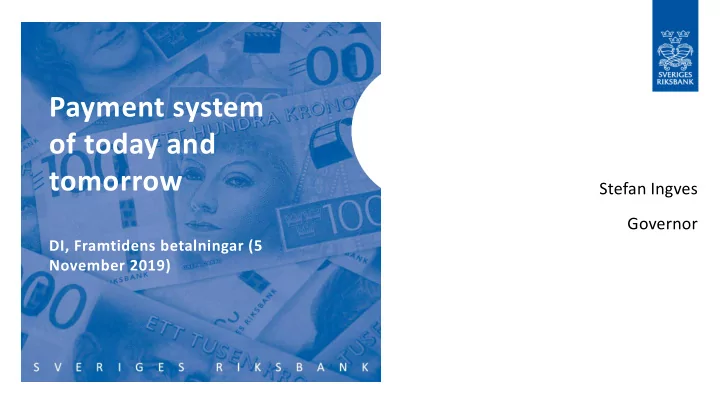

Payment system of today and tomorrow Stefan Ingves Governor DI, Framtidens betalningar (5 November 2019)
What is money?
Rapid changes in the payments market • Central banks must meet the challenges and think in new ways • Use new technologies • Offer new services • Increase international cooperation
Fewer and fewer people are paying in cash Note. Percentage who paid for their most recent purchase in cash Source: The Riksbank
Why do we care about cash?
Cash should remain in circulation Vulnerability Availability Competition
It should be possible to use cash • The status of cash as legal tender needs to be clarified
But people will nevertheless want to pay digitally Per cent Cash Cards Swish Answer to question: “Which means of payment have you used in the past month?” Source: The Riksbank
The Riksbank is the hub of digital payments Customer Customer The Bank A Bank B 1 2 Riksbank
Settlement in state money reduces risk in the system Open 7 -18 R I X Mon-Fri Bank A’s Bank B’s account account Bank B Bank A
Safer settlement through extended RIX • RIX-INST: settlement of instant payments in state money 24/365 • Also in several other countries such as the US and Mexico R I X
The general public should be able to pay digitally with state money through the e-krona 1835 - 1644 2020s?
Matter of urgency to investigate and decide on state role • Government inquiry with broad mandate hopefully early 2020 • Ultimately the decision of the Riksdag – again after 120 years
BigTech and Libra • Libra – Facebook’s attempt to create a ‘global digital currency’ • Private association consisting of multinational corporations • Shall be stabilised through ownership of state assets
International payments are still slow…
...and expensive Average cost to send SEK 2,000 171 kr 180 160 kr 160 142 kr 140 120 97 kr 100 80 60 40 20 0 India China Lebanon Somalia Source: The World Bank
Nordic-Baltic payments as a first step • Smaller scale to show that an international payment system is possible • Historical background: Gold standard 1873
We need to think in new ways – there must be: • Enough physical banknotes in case the electronic systems break down • Possibilities to pay in SEK, with central bank money, 24/365 • An e-krona issued by the Riksbank that is legal tender • Opportunity to make instant payments between currencies 24/365 • (State e-identification)
Recommend
More recommend